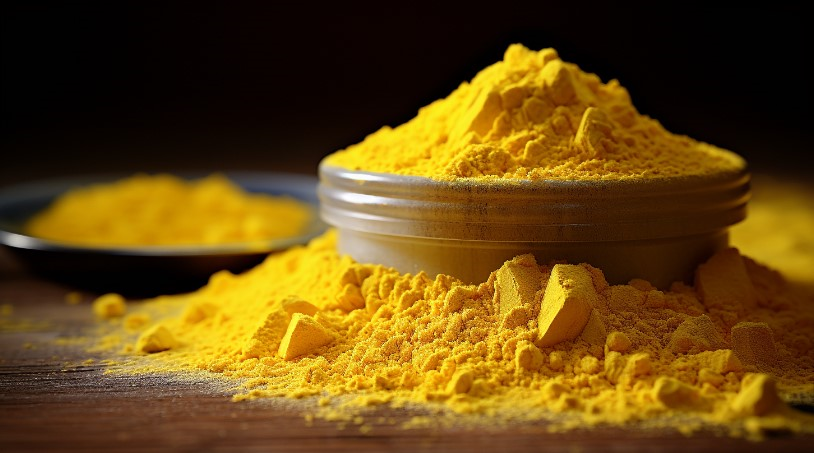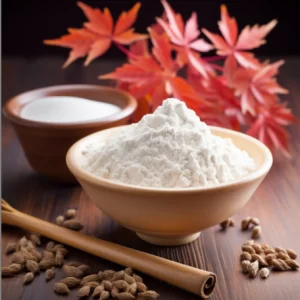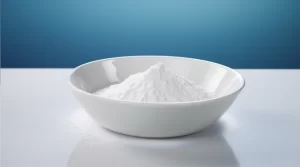Efek farmakologis dari berberin

Berberine, also known as berberine (BBR), is the main active ingredient in coptis. It has a long history of medicinal use in my country. It has antibacterial, antiviral, anti-gastric ulcer and other pharmacological effects. It also lowers blood sugar and lowers blood sugar levels. It plays an important role in blood lipids, anti-tumor and anti-cardio-cerebrovascular diseases.
Berberin antibacterial effect
Berberine has strong pharmacological effects against bacteria, fungi and viruses. It is mainly used clinically to treat gastroenteritis, bacillary dysentery, scabies, suppurative otitis media and conjunctivitis. As a broad-spectrum antibacterial drug, berberine can inhibit the attachment of Gram-positive and Gram-negative bacteria by reducing the number of pili on the bacterial surface; inhibiting the activities of topoisomerase I and topoisomerase II, affecting bacterial DNA Synthesis. In addition, berberine inhibits Escherichia coli by affecting the function of FtsZ cell division protein, and restores the foodborne pathogenic bacteria Cronobacter sakazakii and feces by inhibiting and clearing secretory extracellular polymer biofilms. Susceptibility of enterococci to bacteriostatic drugs.
Berberine anti-inflammatory effect
The anti-inflammatory effect of berberine has been discovered for decades. As early as 1977, Akhter et al. discovered that berberine can alleviate the inflammatory response caused by cholera toxin in rats; subsequently, it was also discovered that berberine can inhibit Swelling of rat ankles caused by carrageenan, increased vascular permeability caused by acetic acid and histamine, swelling of mouse auricles caused by xylene, etc. In the rat endometrial inflammation model, berberine inhibits the infiltration of neutrophils, reduces myeloperoxidase activity, and reduces nitric oxide, TNF-α, and The production of IL-1 inhibits inflammation. In addition, berberine can act on LPS-Toll like receptor 4 (TLR4), an upstream regulator of the cytokine/NF-κB signaling pathway, by weakening NF-κB activity and reducing the expression of TLR4 in mRNA and protein. level of expression, inhibits the secretion of inflammatory factors IL-1, IL-6 and TNF, and exhibits a strong anti-inflammatory effect on inflammation involving macrophages.
Berberine anti-tumor effect
Berberine has obvious inhibitory effects on cervical cancer, oral cancer, esophageal cancer, gastric cancer, colon cancer, melanoma, glioma and leukemia cells. Berberine’s anti-tumor Berberine mechanisms include
Inhibit tumor cell proliferation. Inhibits DNA and protein synthesis, inducing tumor cell cycle arrest in the G0/G1 phase; inhibits COX-2 mRNA expression and the catalytic activity of COX-2 on arachidonic acid ring endoperoxide 2, hindering arachidonic acid ring endoperoxide 2 Oxide 2 combines with the transcription factor PPARγ to activate target gene transcription and promote the process of tumor malignancy; it also inhibits the activities of topoisomerase I and topoisomerase II, effectively interfering with tumor cell DNA replication.
Induce tumor cell apoptosis. Apoptosis is an extremely complex process. Berberine can destroy the double helix structure of DNA; enhance the expression of pro-apoptotic genes Bax and Bad, reduce the expression of anti-apoptotic gene Bcl-2; affect the reactive oxygen species-related signaling pathway JNK /P38, mitogen-activated protein kinase (MAPK), protein kinase C, and extracellular signal-regulated kinase (ERK) activate the endogenous mitochondrial apoptosis pathway, thereby inducing tumor cell apoptosis.
Inhibit tumor cell invasion and metastasis. By inhibiting the activity of activator protein 1, it blocks the signaling pathways related to tumor metastasis; by inhibiting 12-O-tetradecanoylphorbol-13-acetate, GTPase, prostaglandin E2 receptor agonist and transforming growth factor β1-mediated epithelial cell-to-mesenchymal transition inhibits tumor development and metastasis; inhibits tumors by inhibiting cell metastasis-related proteins and reducing the expression of focal adhesion kinase, IKK, NF-κB, U-PA, matrix metalloproteinases 2 and 9, etc. Cell invasion and metastasis.
Berberine hypoglycemic effect
Modern pharmacological research shows that berberine exerts good hypoglycemic effects mainly through: ① activating protein kinase C (PKC), increasing the expression of insulin receptor mRNA, and promoting insulin secretion; ② enhancing insulin receptor substrate 1 (IRS1 ) and the expression of phosphatidylinositol-3-protein kinases (PI3Ks), blocking insulin resistance caused by free fatty acids; ③ By enhancing the expression of glucose transporter 1 (GLUT1), it promotes the uptake of glucose by adipocytes and indirectly activates Glucose transporter 4 (GLUT4) activates AMPK, promotes glucose transport and inhibits the activity of sucrase, maltase, etc. to reduce intestinal absorption of glucose; ④ By stimulating adenosine monophosphate (AMP)-activated protein kinase activity, reducing Body mass index, improve glucose tolerance, activate AMP kinase in adipocytes and muscle cells, increase fat burning, and reduce fat synthesis; ⑤ Promote the regeneration and functional recovery of pancreatic beta cells.
Berberin hypolipidemic effect
Berberine mainly exerts hypolipidemic effects at the post-transcriptional level. Its main mechanisms of action are: ① By activating extracellular signaling pathways such as ERK, it acts on the 3′UTR region of the gene, stabilizing the mRNA of low-density lipoprotein receptor (LDLR). The expression is up-regulated; ② Increase the transcriptional activity of LDLR promoter through the JNK pathway, promote the expression of LDLR and thereby reduce blood lipids. In addition, some studies have found that in the liver cells of rats with non-alcoholic fatty liver disease induced by high-fat diet, berberine can act on the LXRα/Fas signaling pathway in the liver cells and reduce fat in the rat liver cells. Accumulate; reduce the differentiation of preadipocyte 3T3-L1 by inhibiting the transcription of PPARγ and PPARα; activate the AMP-dependent protein kinase (AMPK) pathway to upregulate lipolysis-related genes, inhibit the expression of fat synthesis genes, and reduce triglyceride levels to achieve The effect of regulating blood lipids.
Berberine protect cardiovascular effects
Berberine has positive inotropic, negative frequency, anti-arrhythmic, and enhanced blood pumping functions on the heart; on blood vessels, it can reduce peripheral resistance and improve blood supply.
The anti-arrhythmic effect of berberine is mainly through the following mechanisms: ① Blocking ATP and voltage-sensitive K+ channels, prolonging the action potential duration (ADP) and effective refractory period (ERP) of myocardial cells, thereby changing the unidirectional conduction resistance It is a bidirectional conduction block and relieves reentrant arrhythmias; ② Inhibits α receptors on vascular smooth muscle, thus inhibiting the positive conduction effect of epinephrine, indirectly enhancing the efficacy of acetylcholine and reducing myocardial ischemic ventricular arrhythmias. ; ③ Inhibit hydroxyl free radicals, strengthen the protective effect on myocardial cell membranes, and eliminate various arrhythmias caused by delayed depolarization triggered by calcium overload in myocardial cells.
The antihypertensive mechanism of berberine is as follows: ① Relax peripheral blood vessels by competitively blocking α-receptors on vascular smooth muscle; ② Antagonize cholinesterase activity to accumulate acetylcholine, excite presynaptic membrane M receptors, and inhibit norepinephrine Berberine releases and dilates blood vessels; ③ antagonizes the calcium ion channel of aortic vascular smooth muscle cells, reduces the contractility of the aorta, and has a hypotensive effect; ④ When berberine acts on endothelial cells, it can release nitric oxide (NO) Increases the synthesis capacity of vascular endothelium, thereby achieving the purpose of dilating blood vessels and lowering blood pressure; ⑤ By activating AMPK to reduce endothelium-dependent contraction, it can also inhibit the renin-angiotensin system (RAS) and inflammatory factors involved in the pathological process of hypertension. .
In addition, berberine also exerts anti-platelet aggregation effects through the following mechanisms: ① activates the PPARγ pathway to inhibit the production of cyclooxygenase-2 (COX-2) and reduces the content of thromboxane A2 (TXA2) in platelets; ② inhibits platelet Membrane-associated receptors improve the function of adenylyl cyclase, increase the cAMP content in platelets, inhibit the increase in Ca2+ in platelets, inhibit cyclooxygenase activity, and inhibit the synthesis of TXA2 and prostacyclin I2 (PGI2).
Berberin protective effect against brain injury
Hydrogen peroxide (H2O2) is a highly active molecule in the oxidation process, which can cause cell membrane damage and cell apoptosis and necrosis. After brain injury in adult mammals, it has become a clinical treatment to activate the regenerative ability of neural stem cells (NSCs) in the subependymal layer of the central nervous system and the subgranular layer of the hippocampus to replace dead neurons by promoting nerve regeneration, thereby promoting tissue reconstruction and nerve function repair. important direction. Berberine can enhance the vitality of H2O2-damaged NSCs, improve cell damage morphology, improve the proliferation inhibitory effect of H2O2, and reconstruct brain tissue. For chronic brain damage in rats caused by aluminum trichloride, berberine can improve the learning and memory ability of rats, inhibit hippocampal neuron damage, and increase choline acetyltransferase (ChAT) and superoxide in rat brain tissue. The activity of dismutase (SOD) reduces the expression of acetylcholinesterase (AchE), malondialdehyde (MDA) and monoamine oxidase type B (MAO-B) mRNA. Berberine protects nerve cells from ischemia-reperfusion injury by down-regulating the expression of methyltransferases DNMT1 and DNMT3a, reducing the methylation level of PPARγ promoter. In addition, berberine activates the BDNF-TrkB-PI3K/AKT signaling pathway, inhibits the production of reactive oxygen species, inhibits mitochondrial apoptosis, and improves cerebral ischemia-reperfusion injury in middle cerebral artery occlusion (MCAO), by reducing HIF-1α, caspase -9, caspase-3 and increase Bcl-2/Bax ratio, reduce apoptosis after brain injury. In addition, berberine inhibits the expression of caspase-1 in the penumbra of cerebral ischemia, inhibits the expression of proteins related to the NF-κB signaling pathway, and improves neurological deficits and histopathological morphology of focal cerebral ischemia-reperfusion in rats. Protective effect of nerve cells in the blood penumbra area.
Berberine effect on digestive system
Berberine has long been widely used in China to treat patients with gastroenteritis and diarrhea. Berberine can inhibit H+-K+-ATPase activity, inhibit gastric acid secretion, and protect gastric mucosa. Berberine can inhibit the increase of inflammatory factors IL-1β, TNF-α and NO, inhibit the activation of ileal Toll-like receptor 4 (TLR4) and NF-κB, and increase ileal superoxide dismutase ( SOD) and glutathione peroxidase (GSH-Px) activity to reduce lipopolysaccharide-induced intestinal damage. Berberine can attenuate intestinal epithelial tight junction damage in mice and down-regulate the myosin light chain kinase pathway to improve intestinal damage. Murine endotoxemia. In addition, berberine exerts antidiarrheal effects by inhibiting KCNQ1 channels, reducing cAMP-induced chloride ion secretion in human colon cancer cell T84 cells and increasing the expression of NHE3 and AQP4 in the sennoside A-induced diarrhea model.
Berberine antidepressant and anti-anxiety
Berberine has the effect of antagonizing anxiety and depression caused by morphine withdrawal. Berberine can significantly block the increase in hypothalamic corticotropin-releasing factor (CRF) and locus coeruleus anti-tyrosine hydroxylase (TH) expression, and hippocampal brain-derived neurotrophic factor (BDNF) induced by morphine withdrawal. The expression of mRNA is reduced. The antidepressant effect of berberine may be due to its mechanism of regulating the nitric oxide pathway and central monoamine neurotransmitters in the brain, such as norepinephrine (NE), 5-hydroxytryptamine (5-HT), and dopamine (DA). level.
Referensi:
[1] Fu Lin, Fu Qiang, Li Ji, Tong Xin. Research progress on the chemical components and pharmacological effects of Coptis chinensis [J]. Journal of Traditional Chinese Medicine, 2021, 49(02): 87-92.
[2] Gai Xiaohong, Liu Suxiang, Ren Tao, Liu Yi, Tian Chengwang. Research progress on the chemical components and pharmacological effects of coptis [J]. Chinese Herbal Medicine, 2018, 49(20): 4919-4927.
[3] Qiu Yanping. Research progress on the chemical components and pharmacological effects of Coptis chinensis [J]. Clinical Research in Traditional Chinese Medicine, 2018, 10(22): 141-143.
[4] Xing Yu, Liu Xin, Lin Yuan, Zhang Yong. Research progress on the pharmacological effects of berberine and its clinical application [J]. Chinese Journal of Pharmacology and Toxicology, 2017, 31(06): 491-502.
[5] Zhou Rui, Xiang Changpei, et al. Research progress on chemical components of Coptis chinensis and pharmacological effects of berberine [J]. Chinese Journal of Traditional Chinese Medicine, 2020, 45(19): 4561-4573.
Backvita



